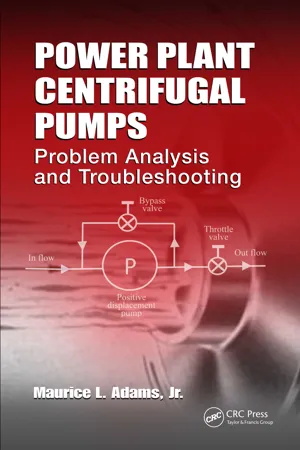
- 162 pages
- English
- ePUB (mobile friendly)
- Available on iOS & Android
About This Book
In the critical work of maintaining power plant machinery, operating difficulties with centrifugal pumps will inevitably occur because of the essential requirement for electric power plants to operate at all times throughout the year. The root causes and solutions for pump failure comprise major areas of study for engineers in seeking the highest availability of electricity-generating units, extending time between major machinery overhauls and providing early detection of potential failure modes well in advance of machine degradation.
This guide for engineers provides a comprehensive overview of the fundamentals of centrifugal pumps, addressing the range of pump operating problems encountered in both fossil and nuclear power plants. The book is divided into three sequential parts: Part I - Primer on Centrifugal Pumps, Part II -Power Plant Centrifugal Pump Applications, and Part III - Trouble-Shooting Case Studies. Employing effective research models developed through years of experience, the author draws on an extensive range of scholarship that covers the detrimental impact of power plant pump failures on overall plant performance, as well as the preventative measures that aid in successful pump maintenance. After covering the performance and components of centrifugal pumps, operating failure modes are covered both for fossil and nuclear power plants. This is followed by the presentation of several power plant pump troubleshooting case studies. The text also walks readers through the various other industrial applications of centrifugal pumps, as in their use within petrochemical plants and in ocean vessel propulsion systems. Recognizing the warning signs of specific impending pump failure modes is essential to minimizing the financial costs of dealing with pump operating problems. To this end, the author lays out a range of theoretical models and relevant examples in support of the essential work of power plant pump use and maintenance:
Frequently asked questions
Information
IPrimer on Centrifugal Pumps
1Pump Fluid Mechanics, Concepts, and Examples
1.1Flow Complexity and Flow-Path Geometry



Table of contents
- Cover
- Half Title Page
- Title Page
- Copyright Page
- Dedication
- In Memoriam: Dr. Elemer Makay (1929–1996)—A Legend in Troubleshooting Power Plant Pumps
- Contents
- Preface
- Acknowledgments
- Author
- Section I Primer on Centrifugal Pumps
- Section II Power Plant Centrifugal Pump Applications
- Section III Troubleshooting Case Studies
- Bibliography
- Index